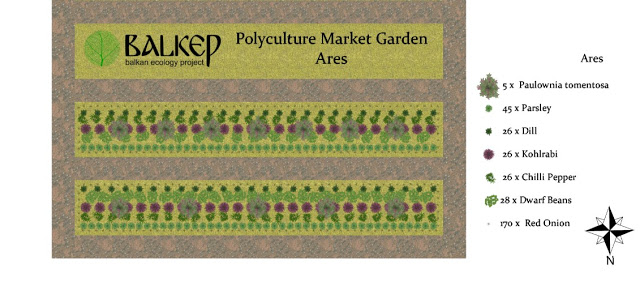Polyculture Project - Market Garden Study - Update 1
This year I'll be posting periodical reviews of what we're getting up to during the Polyculture Study.
Cherry Plum- Prunus cerasifera one of many wild fruit trees in the Market Garden
So, here's what we've been up to in the market garden last week.
New Polycultures
We're trying some new polycultures this year one of which we'll be experimenting with how much mulch we can grow within the beds using a fast growing, nitrogen fixing, biomass producing perennial Paulownia tomentosa.
Paulownia tomentosa 'Shan Tong' are planted in the middle of a 1.2 m wide raised bed to provide biomass for mulch and shade during the hottest periods of summer. These are nitrogen fixing plants and fairly deep rooted so I'm hoping there won't be detrimental competition with the annual crops.
We'll be experimenting with various pruning regimes that will include the regular dropping of the huge leaves and coppicing/pollarding the herbaceous growth. We've called this polyculture Ares.
Ares - Paulownia tomentosa planted 1.5 m apart in the center of the vegetable beds
We have two beds dedicated to this polyculture with the P. tomentosa in one bed planted at 1.5 m apart and another bed 1 m apart. The following annual crops will be planted around the Paulownia.

Ares Polyculture - An experimental polyculture integrating nitrogen fixing, biomass producing perennials with annual crops
We welcome back Kata Prodanov to the study as well as Simon Rogowski, who is also involved in our land stewardship scheme. Simon has been recording some footage for a film we may be making about the polyculture project. The rest of the team will be arriving at various times within the next few weeks.
Sowing Seeds
Tomato seedlings. It's amazing how many plants you can start in a small space. All of the 10 tomato cultivars we are growing this year in the market garden and our home gardens have been sown into two 50 x 30 x 15 cm trays.
We started sowing Tomato and Basil seeds indoors in early March, followed on this week by Aubergine and Chili. These seedlings require 21 to 27 C to germinate so we sow them in large trays and place them in heated rooms. The seedlings are moved out into cloches in the garden in early April and are planted out into the beds in May.
I've been using 14W 225 LED panel lights the last couple of years to prevent the seedlings bending towards the light (Phototropism). They work really well and at just under £20 are great value. Each panel can cover around 50 cm2, but you should be able to cover more area with some clever mirror positioning.
Basil seedlings on the windowsill of a warm room bathed in the red and blue light from the 14 W LED panel lamp.
Parsley was sown outside along with some red onion sets planted into a new polyculture being trialed this year called Ares.
Cloches
We set up cloches in the home gardens where we will be raising many of the crops that will later be planted out in the market garden. Next week we'll be sowing a range of seed in the cloches but it's good to set them up early so that the unwanted seed present in the soil can germinate and be hoed out before the crop seed is sown.
Gathering Materials
We collect spoiled straw from local farmers. The bales being wet are of no use to the farmers for animal bedding and we collect them free of charge. Wet bales can sometimes harbor slugs in which case its not a great idea to use them for mulch in the vegetable garden. Setting chickens on slug infested bales will soon clear the slugs.
Straw bales stacked for future use in the garden
This is a good post, great information. Keep us posted on the chop and drop crop and how it works out.